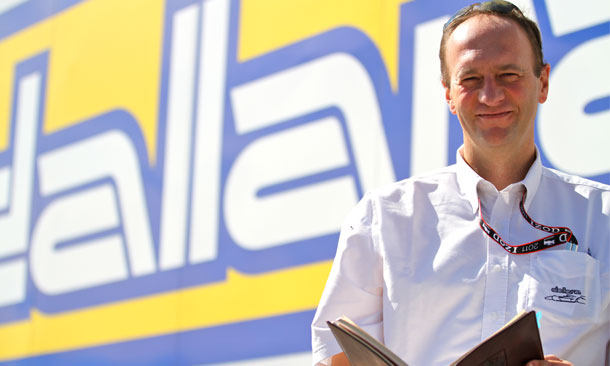Dallara car hits stride after 'thought, listening'
JUL 13, 2012
The house lights dimmed, a fanfare sprung from the speakers and INDYCAR CEO Randy Bernard introduced a hologram depiction of the next-generation IZOD IndyCar Series car. Off stage, Dallara Automobili’s Andrea Toso anxiously waited for the crowd’s response in the packed Indianapolis Museum of Art theater.
Nineteen months later, standing on pit lane of the St. Petersburg (Fla.) street course, Toso again anxiously waited for the response from the sold-out crowd to the new-for-2012 car’s raceability. Finally, after almost two hours of anticipation and expectations that covered two years, Toso -- head of research and development for Dallara -- equaled the exuberance of race winner Helio Castroneves.
It was a sense of victory, too, for the manufacturer, which was recommended by a seven-member advisory committee to design, manufacture and supply the IZOD IndyCar Series car under a price ceiling. Dallara also had produced the previous chassis, which was designed as an oval race car but modified when the series added street/road courses in 2005.
Click it: About Dallara Automobili
Daunting? Sure, but the new car that has been tested and tweaked through 10 races on the most diverse set of racetracks in motorsports is the result of “a lot of thought, a lot of listening before we went into the design phase,” according to Toso.
“This is the secret. Ten years ago you make the last-minute tweaks and worked overnight. This is a revolution. It is as new way of doing things. You have to be clever and design things right the first time, thinking about the use of it in years to come for new engines, new racetracks, drivers who require different things.
“Engineers like innovation with strange and fancy materials, but motorsports has changed. They say it’s not Christmas anymore; the budgets are shrinking. You have to make the best use of what is reasonable to provide good entertainment. If the fans don’t see exotic materials in the car, they’ll say ‘OK.’ They want to see nice-looking, strong products.
“The more you understand the sport the more you realize you don’t need that. I think Formula One went too far, and now they realize that there are no fans. This is what is very clear to INDYCAR; you have to provide a platform for entertainment at a sustainable price.”
By all accounts, the entertainment level of the races has exceeded expectations and quieted pre-season critics who groused about weight differential and aerodynamic drag in addition to the car’s aesthetics. Toso and INDYCAR vice president of technology Will Phillips didn’t expect the seven-month on-track testing phase to be void of chassis and engine manufacturer teething issues, and Dallara absorbed much of the cost of adjustments.
The ICONIC Advisory Committee's attributes of safety, raceability, cost-effectiveness, efficiency, relevant technology, American-made, green and modern look have been rolled into the chassis and engine programs.
“When we signed the contract, the rules were vague,” Toso recounted. “At that time, Honda was the only engine and the suppliers were yet to be chosen. The weight, the performance was unknown. We spent quite a few months with (project manager) Tony Cotman trying to go over the framework. Through Tony, we had input from the team owners, the drivers, mechanics and, in retrospect, we spent a lot of time listening. That lasted till October (2010), and then we started with the wind tunnel with design and CFD because of aerodynamics.
“In a few months we designed all the parts – the struts, brake scoops, hoses, nuts – and this is not difficult and it does not take a lot of people. I would say five designers taking nine months, so you can do the math (about 10,000 man hours). The critical phase is that you have to listen to the series, the engineers, the drivers.
“Once this phase was done, there’s a simple flow.”
A flow continues, with Dallara providing almost daily bulletins to teams regarding parts/systems updates and safety reminders and recommendations along with its continuous testing (prototype rear-wheel guards for 2013 a current example). In the next few years, full production will shift from the company’s Italy base to its new facility in Speedway, Ind.
“I don’t think our people are extraordinary,” Toso said. “I think Dallara is a good company because we listen to the customers first and then we design. When we work together then we do excellent. I’m very pleased.”
















